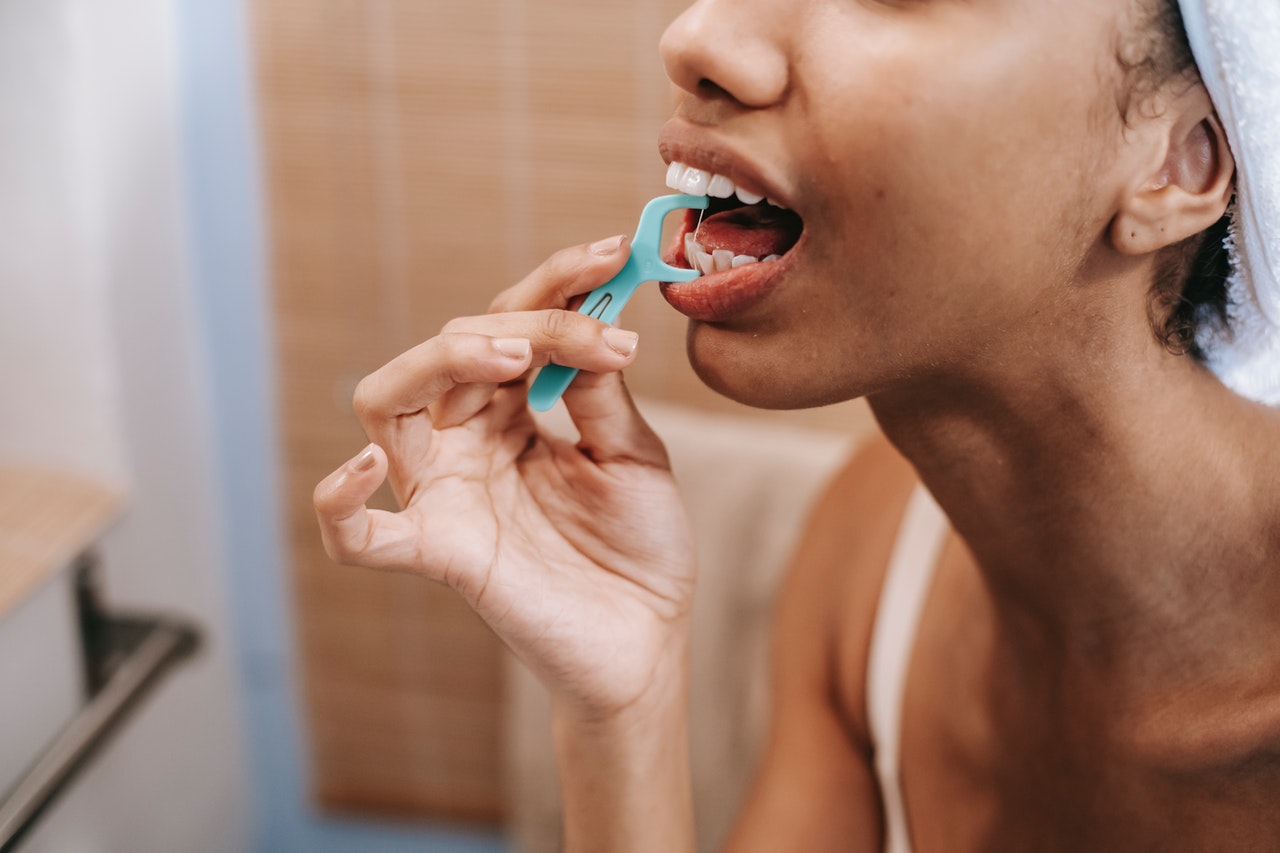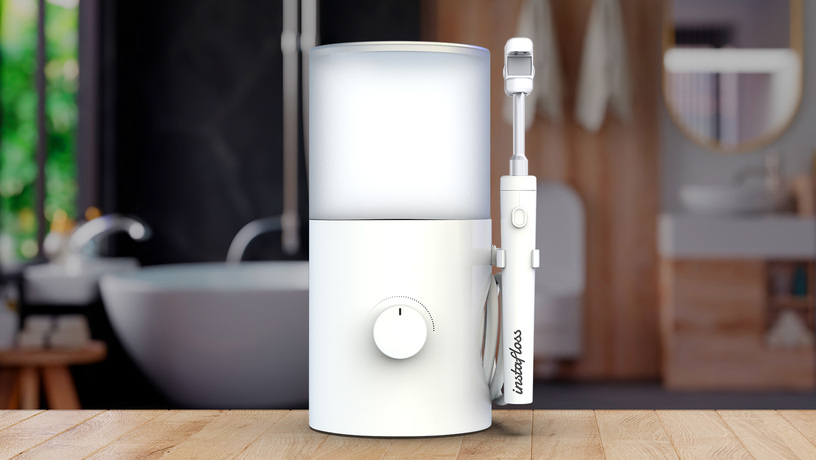Note: This article has been updated as of October 2025 to include changes made by the Mayo Clinic in their article regarding string flossing vs water flossing and also to include information on Instafloss, the automatic flosser.
Flossing may be one of the oldest human routines. “Flossing grooves”, marks from using grass as floss, have been found in hominin teeth fossils going back 1.8 million years. For the vast majority of our existence, we haven’t come too far from our flossing origins of using grass, hair, and twigs to remove pesky chunks of food stuck between our teeth. String floss as we know it came about in the early 19th century, just over 200 years ago. Unsurprisingly, oral health has improved dramatically in that time.
Flossing is a necessary component of the oral care routine. String has been shown to remove more plaque than brushing alone, be doubly as effective at reducing gingivitis than just brushing without flossing, aid in preventing gum disease, and reduce the depth of periodontal pockets.
Despite the benefits, only about 30% of Americans include flossing in their daily oral care routine. People might find it to be too much of a hassle, too painful, or simply not be aware of its importance, and don’t invest the time to include it in their regimen. What’s more, many of those that do floss do not do it correctly.
Then, about 60 years ago, water flossing was introduced to the picture. The first water flosser was developed by a dentist to aid his patients with their oral hygiene (they were probably among the 70% that were neglectful in their flossing routine). Water flossers use pulsating jets of water to flush out bacteria and debris, clean out plaque, and combat gum disease.
It’s only natural to wonder what the pros and cons of water flossing and string flossing are, and if one is preferable to the other.
There are a number of considerations to make when evaluating your preference, including:
- Comfort
- The necessary time investment
- How easy it is to floss correctly
- How likely you are to actually include it in your daily routine
But, before all that, the fundamental point that must be addressed is, “Does it work?” If the answer to this question is anything but a hearty “Yes!”, there are better ways to spend your time than investigating the other factors.
The Science: Does Water Flossing Work?

When we had the idea to create Instafloss roughly five years ago, we needed to verify whether the idea was worth pursuing. Before coming up with blueprints for Instafloss, working out the engineering kinks, or testing the prototypes extensively, we sought answers to the primary concern: Is water flossing effective?
Luckily, we weren’t the first to ask this question since the advent of water flossing. Over the past half century, water has been systematically compared to string as a tool for flossing in the laboratories of research scientists, and their results have greatly informed us.
A number of studies, each isolating a particular element of what it means for flossing to be “effective,” have been conducted. Here are the takeaways from a few of them:
- Water flossing is 129% as effective at removing plaque as string (Goyal CR, et al.)
- Water flossing is 151% as effective at reducing instances of gingivitis (Barnes CM, et al.)
- Water flossing is 200% as effective at reducing gingival bleeding (Rosema NAM, et al.)
- Water flossing can remove up to 99.9% of biofilm, as revealed by using scanning electron microscopy (Gorur, et al.)
- Water flossing is able to disrupt bacteria up to 6mm deep into the periodontal pockets, as opposed to 3mm for string (Drisko, et al.)
- Water flossing can reduce the depths of periodontal pockets in as little as two weeks (Cutler, et al.)
These are just a selection of notable studies, and many more can be found that corroborate the above.
Evidence for String?

While studies conclude that water flossing is superior to string, this isn’t to say that string flossing isn’t effective. String flossing is certainly better than doing nothing, as these studies show:
- Over the course of 6 weeks, flossing and brushing reduced the depth of periodontal pockets by 3.1%, as opposed to 0.4% for brushing alone. Over the same time period, water flossing reduced the depth by 5.0%. (Goyal, et al.)
- Over the course of 6 weeks, flossing and brushing improved the Clinical Attachment Level (an indicator of how well supported the teeth are) by 2.7%, compared to 0.4% for brushing alone. Water flossing improved the Clinical Attachment level by 4.0%. (Goyal, et al.)
- Flossing and brushing the teeth is significantly more effective at reducing plaque than brushing alone, even after just a single use (Terézhalmy, et al.)
That being said, one of the biggest arguments against string floss is that the pain and time it takes results in few including it as part of their daily routines. On top of that, there are some ecological concerns.
Finally, even those who regularly floss with string often do so incorrectly, which has led to several studies and papers questioning the relevance of string floss in modern oral hygiene.
However, while string flossing is certainly effective, the results pale in comparison to the results obtained via water flossing. Despite the evidence showing better results from water flossing, there are still a number of people that claim string flossing is superior. This claim appears to be without merit. Not a single one of the dozens of dentist we've consulted or any person who has written to us arguing in favor of string over water flossing has been able to provide any studies, research, or work done by scientists that support their opinion — and we have searched journals far and wide without being able to find anything that supports string over water flossing (if you would like to share research, please email us at smile@instafloss.com). The closest anyone has come to providing a “source” was by providing a link they found from a Google search which was itself an opinion piece.
There is a wealth of unreliable information on the internet, given that anyone can post an article or blog post. Naturally, these are not comparable to research that is peer reviewed and published in reputable journals that are respected within the scientific community.
Example article spreading misinformation
Perhaps the most baffling instance was when someone told us that string has been shown to be more effective than water (it hasn’t), and provided this Mayo Clinic article as proof. [Edit: we wrote to them and they changed the article this links to! See below for further details.] The article is written by a dentist and says water floss doesn’t remove plaque -- we have seen above in multiple peer-reviewed studies that it does.
The article has a reference section intended to legitimize it, but ironically, upon further inspection it does exactly the opposite. The section contains four references:
The first is a study that compares water flossing to chlorhexidine digluconate (a chemical used to treat gingivitis) and found them to be equally effective -- this is unrelated to the topic of the string vs water, and supports water flossing’s ability to treat gingivitis.
The second reference is the ADA page on flossing, which talks about what floss is, the reasons flossing is necessary, when you should floss, etc. -- essentially an overview on floss. They mention the methods with which one might floss, including string, water, and interdental brushes. There's no mention of water flossing being inferior to string. The ADA also gives its seal of acceptance to water flossers, which is only given to devices that have been objectively evaluated for safety and efficacy (particularly at removing plaque) by an independent body of scientific experts. The ADA page also links to this site (a subsidiary of the ADA) that actually promotes water flossing as an approved and effective method.
The third is a meta-analysis of 395 studies that did not conclude string was more effective than water at removing plaque.
The fourth reference is the author citing himself in the very same article that he is using himself as a reference! This is circular: the author is essentially stating that the support for this article’s veracity is that the article has been written.
This article, and many others that have been provided to us, are blog posts written in the loose format of a paper, sometimes even including a bibliography (as in the example above).
The internet is a wonderful source of information, but it is in parallel a wonderful source of misinformation, unsubstantiated opinions, and circular references.
Update: We contacted the Mayo Clinic about the misinformation in their article (detailed by the paragraph above) and they changed it! They kept the same link, but replaced it with a new article. There is hope for the internet after all! However, the bad news is that many pop-med blogs out there (including WebMD) are still quoting the now-removed Mayo Clinic article. Our next step is to contact the remaining blogs and let them know that the Mayo Clinic has taken down the misinformation. We took screenshots of the old article as well as the new, so if you are curious to see a side-by-side comparison, email us at smile@instafloss.com and we will be happy to provide the evidence.
Instafloss vs one-jet water flossers

Although advancement has been made since the inception of water flossing, there is a common factor between all water flossing devices prior to Instafloss, regardless of brand or model: they all use one jet.
Instafloss uses multiple water jets to accomplish what manual 1-jet water flossers do, but in ten seconds - a mere twelfth of the time.
However, unlike manual 1-jet water flossers, the Instafloss mouthpiece aims pulsing water jets at 90° to the gumline (a 50% more effective angle, as per Eakle WS et al.) on both sides, front and back, of your top and bottom teeth. This way, Instafloss is always aimed at the most effective angle and never misses a spot, 360 degrees around each tooth. Because multiple jets overlap, they clean the same spot multiple times. Through this multi-jet system, Instafloss can give a better, more thorough water floss in only 10 seconds.
We based Instafloss on the science that was done on the single jet water flossers that preceded it. The jet technology is unchanged, the innovation with Instafloss is that there are multiple jets precisely placed for an optimal clean. With the abundance of science supporting the efficacy of water flossing, we still wanted to be sure we created an effective device. As such, we conducted our own studies and found our hypothesis was correct!
We found Instafloss to be 200% as effective as string, and 50% more effective than a leading brand one-jet water flosser at reducing the depth of periodontal pockets and gingival bleeding.
We believe these results may be due to people’s difficulties in aim and application when using a single jet; for best results when using a single jet water flosser, the user needs to aim correctly at 90 degrees to the gumline, never missing a spot, on both sides of the gumline -- a very hard task, indeed, especially over such a long period of time. By removing the need to aim, Instafloss essentially becomes the perfect application of a water floss.
Conclusion
Flossing is a crucial, but often neglected part of the oral care routine. After decades of research, it is abundantly clear that water flossing is more effective at removing plaque, reducing bleeding, cleaning more areas, reducing gingival pockets, and reducing gingivitis than string floss.
However, single-jet water flossers take longer than string to floss, which is part of the reason why so few people floss as regularly as they should. It is also difficult to get the most effective floss out of them, given the need to aim and trace the gumline manually. These are problems Instafloss was designed to solve.
We are enthused that Instafloss is much easier to implement due to its comfort, low time investment, and reduced dexterity requirement. Finally, with a much more convenient flossing option, people can take full advantage of water flossing without the time-commitment and hassle.
With the majority of people skipping out on flossing entirely, we’re excited to make it a more achievable component of daily oral care. Aside from reducing the likelihood of needing expensive, painful, and preventable oral surgeries down the line, our overall health (such as diabetes, heart disease, alzheimers, arthritis, and even erectile dysfunction) is linked to our oral health in surprising ways! Given the importance of oral health, and its influence on our overall health, this is a very important mission for us — one too important to rely on anything but science.
Sources:
-
https://www.abc.net.au/science/articles/2003/11/06/983592.htm
-
https://aap.onlinelibrary.wiley.com/doi/abs/10.1902/jop.1989.60.5.243
-
https://aap.onlinelibrary.wiley.com/doi/abs/10.1902/jop.1998.69.7.759
-
https://instafloss.com/blogs/news/the-complete-history-of-oral-irrigation-water-flossing
-
http://www.studiodottorpiana.it/aaapdf/articolo%20idropulsore.pdf
-
The_Effect_of_Different_Interdental_Cleaning_Devices_on_Clinical_Parameters
-
https://www.sciencedirect.com/science/article/abs/pii/S0889540607013492
-
https://aap.onlinelibrary.wiley.com/doi/abs/10.1902/jop.2008.070345
-
https://instafloss.com/blogs/news/refillable-floss-eco-review
-
https://journals.sagepub.com/doi/abs/10.1177/154405910608500404
-
https://www.mayoclinic.org/healthy-lifestyle/adult-health/expert-answers/dental-floss/faq-20058112
-
https://www.sciencedirect.com/science/article/abs/pii/S0002870307005418#!
-
Are Porphyromonas gingivalis Outer Membrane Vesicles Microbullets for Sporadic Alzheimer’s Disease Manifestation?
-
https://onlinelibrary.wiley.com/doi/epdf/10.1034/j.1600-051x.2000.027004267.x




1 comment
What does “90 degrees to the gumline” mean? Both a trajectory perpendicular to the front (or rear) surface of the tooth, and a trajectory parallel to the tooth surface and pointing straight down to the gums, could be geometrically perpendicular to the gumline. Which did you mean?
———
Instafloss replied:
Hello Jonathan,
Great question! We had meant your first interpretation – a trajectory perpendicular to the tooth, parallel to the ground (if you’re standing up straight).
With Smiles, The Instafloss Team